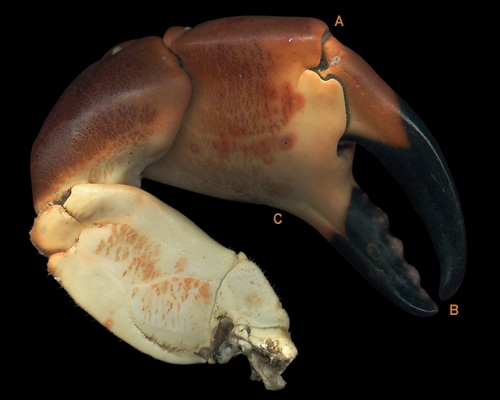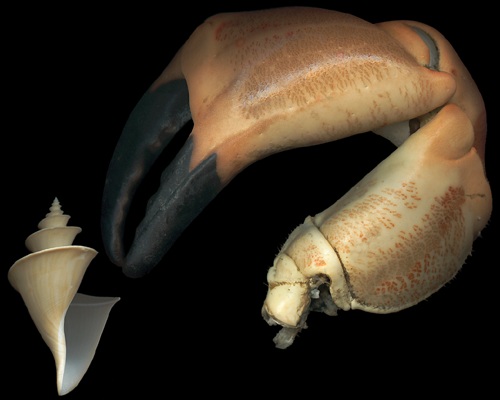Monster Jonah fished off Normandy, France, april 2004.
Cancer pagurus Linnaeus 1758, is one of the most famous crabs of the N.E. Atlantic, a sign of what can produce and nourish the ocean when it is generous. It is close to Cancer irroratus Say 1817 and Cancer borealis Stimpson 1859.
These two last species are fished along the NE. coast of America, from Labrador, Nova Scotia south to S. Carolina, Florida, when pagurus ranges from Norway to Morocco.
The american Jonah crabs are quite big animals; great specimens can reach to 6Kg, the average weight being between 2 and 3 Kg. Size: 15 to 20cm for an adult, up to 25cm.
The "Tourteau", our european Jonah, lives intertidally down to 100m deep, and is a great walker: journeys of 150km per week are not absolutely rare, and 50km/month are common. Size: 9cm to 15cm large, up to 285mm for an extreme old timer (MNHN sample). It is a little bit smaller than its american relatives.
These two last species are fished along the NE. coast of America, from Labrador, Nova Scotia south to S. Carolina, Florida, when pagurus ranges from Norway to Morocco.
The american Jonah crabs are quite big animals; great specimens can reach to 6Kg, the average weight being between 2 and 3 Kg. Size: 15 to 20cm for an adult, up to 25cm.
The "Tourteau", our european Jonah, lives intertidally down to 100m deep, and is a great walker: journeys of 150km per week are not absolutely rare, and 50km/month are common. Size: 9cm to 15cm large, up to 285mm for an extreme old timer (MNHN sample). It is a little bit smaller than its american relatives.

Live C. pagurus. Picture © Robert Borzymek, underwater.pl
Little Gibbula cineraria on top right.
Little Gibbula cineraria on top right.
The Chelipeds:
All the crabs have transformed their first pair of thoracic appendices into a kind of arms including, from the test to the extremities, the following parts:
- the Merus. If we had a merus, it would contain the biceps for example.
- the Carpus (knee);
- the Propodus (the segment between the knee and the two fingers);
- the Fingers; the upper one is movable (this is the Dactyl), the lower not.
Fingers and Propodus form what is named the Chela. The whole member is named a Cheliped.
In the picture above, this Jonah shows its left arm to the photograph; notice that the Merus is hidden under the shell (usual posture at rest). In many species, one cheliped is used to hold and peel the edible things, when the other is intended to crush and break. This last arm is often bigger, especially in old specimens. Paradoxically, it seems that something "impairs muscle performance in larger claws" (1).
Interesting measures are the lenghts of the Dactyl, and of the Propodus along its axis: adult specimens have a Carapace-width /Propodus-lenght ratio around 4.5, when older specimens can get a ratio of 3.0 with their bigger arm, which means they carry a quite interesting piece of meat. The ratio Carapace/Dactyl is broadly equivalent, and gives identical indications (2).
This little tool, even if it is not very accurate, can give an idea of the owner's size when we have just one of its Chelipeds in our plate.
(1) G.M. Taylor [Evolution, Vol.55 N°3] 2000
(2) survey carried out into 60 unhappy Brown Crabs (the vernacular name of our Jonah) of any size.
- the Merus. If we had a merus, it would contain the biceps for example.
- the Carpus (knee);
- the Propodus (the segment between the knee and the two fingers);
- the Fingers; the upper one is movable (this is the Dactyl), the lower not.
Fingers and Propodus form what is named the Chela. The whole member is named a Cheliped.
In the picture above, this Jonah shows its left arm to the photograph; notice that the Merus is hidden under the shell (usual posture at rest). In many species, one cheliped is used to hold and peel the edible things, when the other is intended to crush and break. This last arm is often bigger, especially in old specimens. Paradoxically, it seems that something "impairs muscle performance in larger claws" (1).
Interesting measures are the lenghts of the Dactyl, and of the Propodus along its axis: adult specimens have a Carapace-width /Propodus-lenght ratio around 4.5, when older specimens can get a ratio of 3.0 with their bigger arm, which means they carry a quite interesting piece of meat. The ratio Carapace/Dactyl is broadly equivalent, and gives identical indications (2).
This little tool, even if it is not very accurate, can give an idea of the owner's size when we have just one of its Chelipeds in our plate.
(1) G.M. Taylor [Evolution, Vol.55 N°3] 2000
(2) survey carried out into 60 unhappy Brown Crabs (the vernacular name of our Jonah) of any size.
Pictures of the dish:

This one was fished off Granville, W. Normandy.
Dimensions: AB (dactyl) 95mm. AC 75mm. We can move a finger between the two digitations.
If we accept the smaller ratio, which is 3 for old fellows with a big arm, between Carapace and Dactyl or Propodus, we find a pagurus of 275 to 285mm width, "without attachments" :)
A bigger ratio (4.5 for average adult) would lead us to a surnatural size (40 to 45cm).
Dimensions: AB (dactyl) 95mm. AC 75mm. We can move a finger between the two digitations.
If we accept the smaller ratio, which is 3 for old fellows with a big arm, between Carapace and Dactyl or Propodus, we find a pagurus of 275 to 285mm width, "without attachments" :)
A bigger ratio (4.5 for average adult) would lead us to a surnatural size (40 to 45cm).

Let's make this page shell-related. Height of this Thatcheria: 74mm. This crab was a BIG one.
Unfortunately, the remaining of the animal was lost, has not been fished, or was eaten by the fisherman, his family and all his friends. We will thus never know the exact size of this splendid Cancer pagurus.
Unfortunately, the remaining of the animal was lost, has not been fished, or was eaten by the fisherman, his family and all his friends. We will thus never know the exact size of this splendid Cancer pagurus.